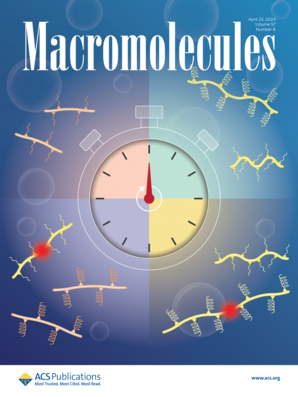CO2-Triggered Hydrogelation: Architectural Insights from Random and Graft Polyelectrolytes
IF 5.1
1区 化学
Q1 POLYMER SCIENCE
引用次数: 0
Abstract
The sol–gel transition of CO2-responsive polyelectrolytes is driven by electrostatic interactions between anionic groups and protonated cationic moieties, yet the critical roles of ionic stoichiometry and spatial architecture in mediating gelation behavior remain poorly understood. To address this knowledge gap, two distinct copolymer series with varying configurations and anion/CO2-responsive monomer ratios were synthesized: P(AA-co-DPM) random copolymers via free radical copolymerization of acrylamide, acrylic acid, and dimethylaminopropyl methacrylamide (DMAPMAm), while PAA-g-PDPM graft copolymers through the covalent attachment of poly(DMAPMAm) side chains to poly(AM-co-AA) backbones. CO2-induced protonation led to contrasting phase behaviors contingent on ionic balance. For P(AA-co-DPM) aqueous solution, viscosity decreased when nDMAPMAm ≤ 0.83nNaAA, increased when nDMAPMAm ≥ 1.13 nNaAA, and resulted in precipitation when nDMAPMAm = 0.83nNaAA. Conversely, the PAA-g-PDPM aqueous solution exhibited continuous viscosity enhancement up to nDMAPMAm ≤ 0.65nNaAA, followed by dehydration at higher cationic ratios. Notably, the graft architecture demonstrated superior gelation under CO2 exposure, forming robust hydrogels with frequency-independent modulus (0.01–0.1 rad·s–1) and minimal energy dissipation (tan δ < 0.1). In contrast, random copolymers yielded fragile networks displaying frequency-dependent moduli and elevated tan δ (>0.1). Rheology-small angle neutron scattering analysis revealed that graft copolymers underwent CO2-induced chain collapse from swollen to compact conformations, creating physical cross-links, whereas random chains maintained Gaussian statistics regardless of protonation state. These findings highlight that extended cationic side chains in graft architectures enhance intermolecular entanglement and directional electrostatic interactions, offering a strategic approach for designing CO2-responsive hydrogels with tailored mechanical properties through molecular architecture engineering.

二氧化碳引发的水凝胶:随机和接枝聚电解质的建筑见解
二氧化碳响应型聚电解质的溶胶-凝胶转变是由阴离子基团和质子化阳离子基团之间的静电相互作用驱动的,但离子化学计量学和空间结构在介导凝胶化行为中的关键作用仍然知之甚少。为了解决这一问题,研究人员合成了两个具有不同构型和阴离子/二氧化碳响应单体比例的不同共聚物系列:P(AA-co-DPM)随机共聚物,通过丙烯酰胺、丙烯酸和二甲氨基丙基甲基丙烯酰胺(dmapam)的自由基共聚,而PAA-g-PDPM接枝共聚物通过聚(AM-co-AA)侧链共价附着在聚(AM-co-AA)骨架上。co2诱导的质子化导致了不同离子平衡的相行为。对于P(AA-co-DPM)水溶液,当nDMAPMAm≤0.83nNaAA时粘度降低,当nDMAPMAm≥1.13 nNaAA时粘度增加,当nDMAPMAm = 0.83nNaAA时产生沉淀。相反,PAA-g-PDPM水溶液粘度持续增强,直至nDMAPMAm≤0.65nNaAA,然后在较高阳离子比下脱水。值得注意的是,在CO2暴露下,接枝结构表现出优越的凝胶化,形成了具有频率无关模量(0.01-0.1 rad·s-1)和最小能量耗散(tan δ <;0.1)。相比之下,随机共聚物产生的脆弱网络显示出频率相关的模量和升高的tan δ (>0.1)。流变学-小角中子散射分析表明,接枝共聚物在co2诱导下发生了从膨胀到致密构象的链塌缩,形成了物理交联,而无论质子化状态如何,随机链都保持高斯统计。这些发现强调了接枝结构中延伸的阳离子侧链增强了分子间纠缠和定向静电相互作用,为通过分子结构工程设计具有定制机械性能的二氧化碳响应水凝胶提供了一种战略方法。
本文章由计算机程序翻译,如有差异,请以英文原文为准。
求助全文
约1分钟内获得全文
求助全文
来源期刊

Macromolecules
工程技术-高分子科学
CiteScore
9.30
自引率
16.40%
发文量
942
审稿时长
2 months
期刊介绍:
Macromolecules publishes original, fundamental, and impactful research on all aspects of polymer science. Topics of interest include synthesis (e.g., controlled polymerizations, polymerization catalysis, post polymerization modification, new monomer structures and polymer architectures, and polymerization mechanisms/kinetics analysis); phase behavior, thermodynamics, dynamic, and ordering/disordering phenomena (e.g., self-assembly, gelation, crystallization, solution/melt/solid-state characteristics); structure and properties (e.g., mechanical and rheological properties, surface/interfacial characteristics, electronic and transport properties); new state of the art characterization (e.g., spectroscopy, scattering, microscopy, rheology), simulation (e.g., Monte Carlo, molecular dynamics, multi-scale/coarse-grained modeling), and theoretical methods. Renewable/sustainable polymers, polymer networks, responsive polymers, electro-, magneto- and opto-active macromolecules, inorganic polymers, charge-transporting polymers (ion-containing, semiconducting, and conducting), nanostructured polymers, and polymer composites are also of interest. Typical papers published in Macromolecules showcase important and innovative concepts, experimental methods/observations, and theoretical/computational approaches that demonstrate a fundamental advance in the understanding of polymers.
 求助内容:
求助内容: 应助结果提醒方式:
应助结果提醒方式:


